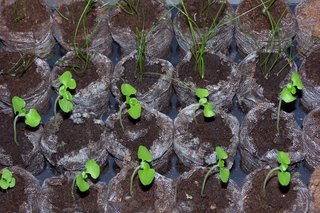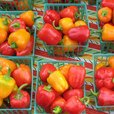 Here are my chive and basil plants. I will be planting the chives this weekend, the basil will have to wait another two weeks though, to be out of danger of frost.
Here are my chive and basil plants. I will be planting the chives this weekend, the basil will have to wait another two weeks though, to be out of danger of frost.
Chives are the most wonderful herb to use. I love the smell of them when and they make a beautiful flower centerpiece. Sometimes I think using natural to decorate the house in the spring and summer makes any gloomy room or day bright and cheerful, and it's cheap.
Chives taste like a sweeter, milder version of an onion, true, but that doesn't make them boring, that makes them versatile! And, although we usually just eat the leaves, all the parts of chives are edible: the bulbs the leaves spring from, the leaves themselves--even the flowers! Toss them on salads for added color and crunch or use them to garnish plates.
Chives grow best in full sun in a fairly rich, moist soil, which is high in organic matter, and has a pH of 6 to 8. Chives will, however, tolerate partial shade and most soil types. Chives should be fertilized several times during the growing season with a balanced commercial fertilizer or bone meal and manure. Although specific recommendations are not available for chives, a general recommendation is to incorporate 50 to 75 pounds each of nitrogen, phosphate, and potash per acre at planting. Sidedress with an additional 10 to 15 pounds of nitrogen two times during the growing season. Chives should be kept well watered and weeded.
Planting and Culture
Chive seed germinate easily, but slowly. Sow seed about 1/2 inch deep in flats containing a peat-based soilless mix. Maintain constant moisture and a soil temperature of 60 to 70 F. In four to six weeks, the young plants can be planted outdoors, preferably after all danger of frost is past. Chives can also be direct seeded outside when the soil is warm, but then few if any leaves should be harvested that first year. Chives may be propagated by simply dividing large clumps into smaller clumps of about 5 bulbs each at any time during the growing season. All plantings should be divided every two to three years to prevent over-crowding. Space plants 4 to 15 inches apart in rows 20 or more inches apart, depending on the width of the cultivator that will be used. Chives are bothered by few disease or insect pests.
Harvesting
Leaves can be harvested after established plants are 6 inches tall. To harvest, simply cut the leaves 2 inches above the ground. Usually, in home gardens or small herb operations, all the leaves of a clump of plants are not cut off at one time. This allows that same clump of plants to be cut over and over again throughout the growing season. In larger operations where this approach is unpractical, the entire clump of plants is cut 2 inches above the ground, but then it takes several weeks before that clump can be recut again. The new growth, however, will be very tender. All plants should be cut regularly to encourage new bulblets to develop, to prevent leaves from becoming tough, and to prevent flower formation.
April 7, 2006
Chives Make Any Food Better
Subscribe to:
Post Comments (Atom)









4 comments:
Lots of good info!
I have some sprouting that I am hoping to plant this weekend also!
Ahhh...the chives. I have an abundance of chives in my front flower bed. Not by choice though :) They are one hearty plant that just does not give up and lets itself be known just that by spreading wherever it pleases. I do love them on baked potatoes with sour cream though, so I can't complaing TOO much :) If they would just listen to me and stay in one area, I'd like them so much better :)
If your chives are getting too out of control just dig them up and split the plants up. Replant some for yourself and then give them to a friend so they can enjoy this wonderful herb also.
thanks Lana. I get these little buggers under control. :)
Post a Comment